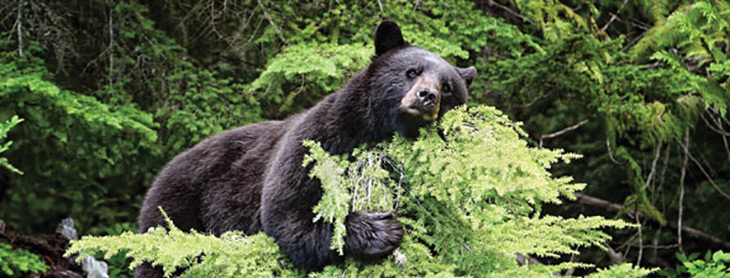
Bears are multi-faceted individuals, not that unlike us. Bear characteristics can only be generalized so much, but we’ll do our best to give you some general traits.
Bears are highly evolved social animals with intelligence comparable to that of the great apes. Bears often share friendship, resources and security. They form hierarchies and have structured kinship relationships.
Bears are not as unpredictable and dangerous as Hollywood or the media would have us believe. Bears exhibit very predictable behaviour. This trait can be beneficial to people who come into contact with bears.
Bears are not mean or malicious; they are very gentle and tolerant animals.
The intelligence of this animal never fails to amaze me. I observed and photographed [a] bear moving a log into place so she could walk across it and get to the other side of a creek without swimming. This was an animal using a tool to accomplish a task – an ability normally accredited to only humans and chimpanzees. Bears are truly amazing. – Bill Lea, Wildlife Photographer as quoted in Living with Bears, by Linda Masterson
Mother bears are affectionate, protective, devoted, strict, sensitive and attentive with their young. Not unlike people, bears can be empathetic, fearful, joyful, playful, social and even altruistic. They’re all individuals and have unique personalities.
Cubs, as well as older bears, engage in social play and have ritualistic mechanisms to meet strangers and decide if they are friendly or not. Bears routinely distinguish between threatening and non-threatening human behaviour.
Bears communicate using body language, sounds and smells. Bears treat humans just as they would other bears; the problem is that bears are very physical with each other, with the intentional use of bites, swats or body posturing.
Bears are beautiful, sentient beings who are extremely large in personality, polite, and even empathetic. They also have a keen sense of community, and are not as solo and independent as people have suggested they are. They are peaceful, thoughtful, emotionally intelligent animals who truly love their kids. They are trustworthy, and that is especially true of a mother and her cubs. They have a jolly sense of humour, curiosity and compassion. ~ Ellie Lamb, Bear Viewing Guide
Bears live in a rich and complex scent-defined world. They depend on their acute sense of smell for information about the world around them. Their smelling ability is extremely sensitive, with one hundred times more nasal mucosa area than a human. A complex system of social messages are communicated through trails of airborne scent; scent transferred to twigs, branches and grasses; and scents left on purpose by tree rubbing or biting, as well as scat or urine marks. In the ursine world, these messages combine to become the daily newspaper.
A bear’s hearing ability is excellent, and like dogs, bears hear high pitches, exceeding human frequency range and sensitivity.
Bears see in colour and have good vision, similar to humans.
Bears are fast; they can run more than 60 kilometers an hour (37 mph) – that’s twice as fast as an Olympic sprinter. In fact, a bear can outrun a race horse over short distances, but has little endurance. To put their speed in perspective, bears can run 15 meters per second (50 feet per second).
The more I study bears, the more variability I see, and the harder it is to answer questions about them. Individuals have different personalities, and much of the behavior of these intelligent animals is based on learning. – Dr. Lynn Rogers
Bears are very strong and powerful animals. They have been known to bend open car doors and pry open windshields in their search for food. Bears routinely roll over huge rocks and logs in search of food. A grizzly’s powerful digging ability allows them to feed on roots, bulbs, and rodents, as well as dig dens on steep mountain slopes.
Size, body weight and color vary between species and from habitat to habitat. Learn to identify the difference between blacks and grizzlies.
